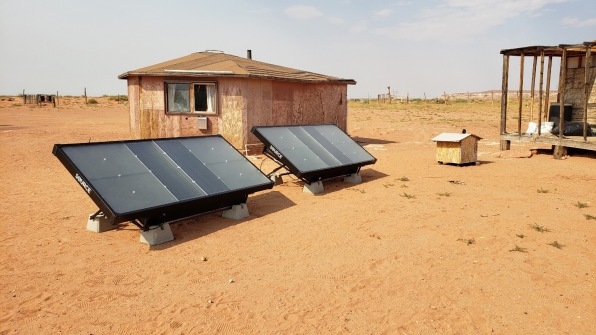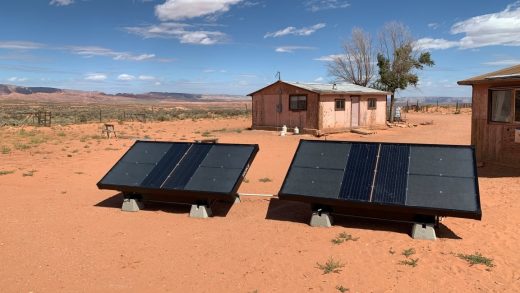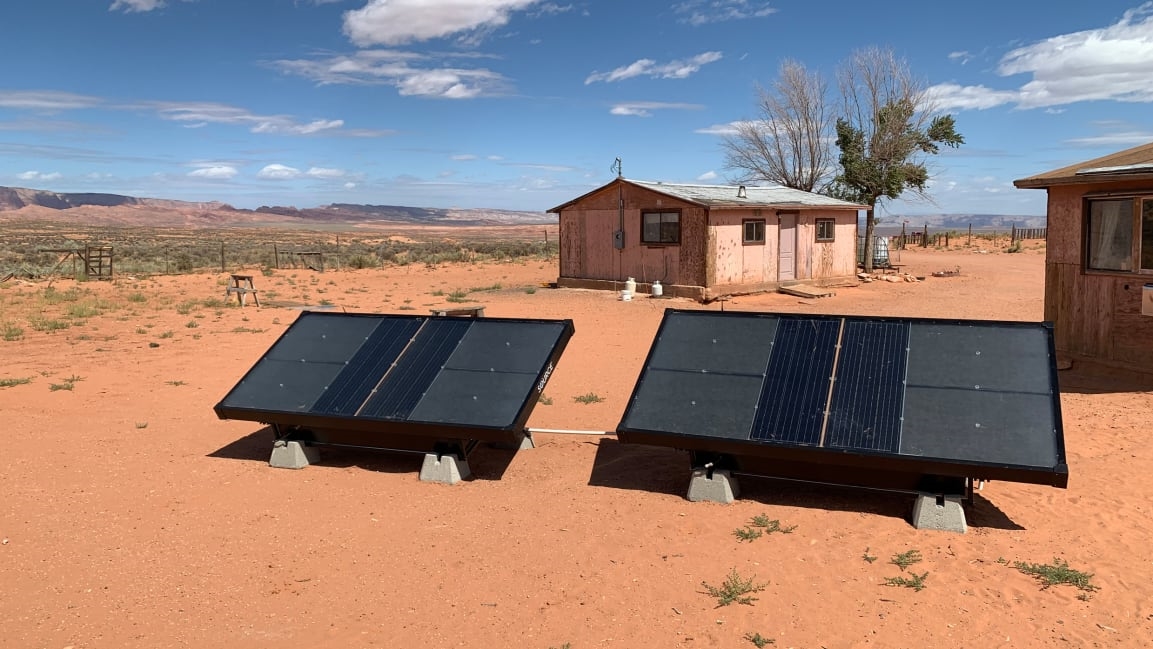This tech is bringing water to Navajo Nation by pulling it out of the air
In the Navajo Nation, sometimes a single spigot on an empty road is the only water source around for hundreds of residents. Others have to drive from their rural homes into towns miles away to buy all the water they need for cooking, drinking, cleaning, and livestock, because there’s no infrastructure to bring it through pipes. About 40% of households in the Navajo Nation live without running water. But now, at a few houses, panels positioned on the ground pull moisture from the air, connecting to a tap inside the home and providing up to 10 liters of water—or about 20 16-ounce bottles—a day, at no cost to the family.
The panels come from Zero Mass Water; the company’s Source hydropanels use sunlight to absorb water vapor from the air, even in arid climates. Zero Mass Water partnered with local Navajo governments and Navajo Power, a public benefit corporation working to install solar polar on tribal lands, for an initial demonstration project in which 15 homes received two Source panels each, for a total of 30 panels. Those initial panels were funded by Barclays and The Unreasonable Group, an accelerator for socially minded startups.
Each Source hydropanel can make up to 3 to 5 liters of water a day; with two panels, a home can get up to 10 liters a day, and each panel can store 30 liters of water, or 60 16-ounce bottles of water, for when cloud cover may affect production. The panels last for 15 years.

“These homes are very rural. You could drive for 10 minutes down the highway between homes; you’re never going to get a pipe [installed],” says Cody Friesen, Zero Mass Water CEO. This land, he adds, is about the same size as the state of West Virginia, with a population of 175,000—54,000 of which have no water. “This is a solvable problem,” he says.
The Navajo Nation has at points during the pandemic had the highest COVID-19 infection rate per capita in the U.S., worsened by the fact that residents can’t easily access water to wash their hands and have to make frequent trips into town to buy water. Zero Mass Water first started communicating with the Navajo Nation about three years ago, but the pandemic has heightened the urgency for this partnership. The company worked with chapter leaders—the Navajo Nation has 110 chapters, which are geographical divisions like counties—to find the people most in need.
“When you have an average family of five or six in a household, and they have a herd of sheep and maybe a couple horses and cattle, the water doesn’t last too long. They have to make another run into town,” says Jerry Williams, president of the LeChee Chapter of the Navajo Nation. Some families, he says, are fortunate enough to have 225-gallon tanks on their pickup trucks, so they can haul more water at once; others are not.
Williams admits he was a bit skeptical when Navajo Power first approached him about this project. “I said, ‘Well you’re going to have to show me, you’re going to have to make me see it to believe it,’” he says. It was tricky to explain to community members what exactly they’d be getting, too, but he talked with the Navajo families in LeChee that would be a part of this initial demonstration project and visited their homes when the panels were installed and the water taps turned on.
Now, Williams hopes more Navajo chapters and leaders can find out that this technology exists. “To go through this, to be skeptical and then to the time where you actually feel it, taste it, then you’re game,” he says. “Then you think about, ‘Wow, how can we get this out to the other communities?’” Zero Mass Water wants the same. The company is hoping this initial project can prove that its Source panels can be a solution for the entire Navajo Nation’s water crisis, with support from CARES Act funding.
This technology can scale, Friesen says, but it will take money. To outfit all the Navajo Nation homes in need of water with Source panels would be about $40 to $70 million. The Navajo Nation received $714 million total in CARES Act funding to cover expenses “incurred due to the public health emergency,” such as making sure people have running water to wash their hands. This solution would account for about 5 to 10% of that total allotment. “I’m hoping that each of the 110 chapters can at least utilize some of this equipment. I know there’s a lot of people that live off the grid, that live 6, 7, 10 miles off the main water line,” Williams says. “I know that there is need.”
(20)



